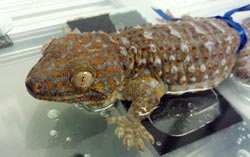Not Slippery When Wet: Geckos Adhere to Surfaces Submerged Underwater

A tokay gecko (Gekko gecko) sits on a wet surface prior to adhesion tests. Geckos were pulled horizontally using a small pelvic harness (blue ribbon) attached to a motorized force sensor where the maximum force a gecko could cling was measured.<br><br>Credit: Ethan Knapp and Alyssa Stark, The University of Akron<br>
Geckos are known for their sticky adhesive toes that allow them to stick to, climb on, and run along surfaces in any orientation–even upside down! But until recently, it was not well understood how geckos kept their sticking ability even on wet surfaces, as are common in the tropical regions in which most geckos live.
A 2012 study in which geckos slipped on wet glass perplexed scientists trying to unlock the key to gecko adhesion in climates with plentiful rain and moisture.
A study supported by the National Science Foundation and published in the Proceedings of the National Academy of Sciences this week solves the mystery, showing that wet, water-repellant surfaces, like those of leaves and tree trunks, actually secure a gecko's grip in a manner similar to dry surfaces.
Researchers from the University of Akron, led by integrated bioscience doctoral candidate Alyssa Stark, tested geckos on four different surfaces. The surfaces ranged from hydrophilic–those that liquids spread across when wet, like glass–to hydrophobic–water-repellent surfaces on which liquids bead, like the natural leaves geckos walk on–and intermediate ones, like acrylic sheets. Geckos were tested on these surfaces both when the surfaces were dry and when they were submerged underwater, and water completely covered the gecko's feet.
Fitting a small harness around the pelvis, geckos were gently pulled along the substrate until their feet began to slip. At this point the maximum force with which a gecko could stick was measured. On wet glass geckos slipped and could not maintain adhesion. However when tested on more hydrophobic surfaces, geckos stuck just as well to the wet surface as they did to the dry ones. When tested, geckos stuck even better to wet Teflon than dry.
To understand these findings, researchers developed a model that explains the results from the gecko study and may also help inform future bio-inspired gecko-like adhesives that can maintain adhesion underwater.
For more details, see: Geckos keep firm grip in wet natural habitat.
Media Contacts
Bobbie Mixon, NSF (703) 292-8070 bmixon@nsf.gov
Denise Henry, University of Akron henryd@uakron.edu
Lisa-Joy Zgorski, NSF (703) 292-8311 lisajoy@nsf.gov
Program Contacts
Andrew J. Lovinger, NSF (703) 292-4933 alovinge@nsf.gov
The National Science Foundation (NSF) is an independent federal agency that supports fundamental research and education across all fields of science and engineering. In fiscal year (FY) 2012, its budget was $7.0 billion. NSF funds reach all 50 states through grants to nearly 2,000 colleges, universities and other institutions. Each year, NSF receives about 50,000 competitive requests for funding, and makes about 11,500 new funding awards. NSF also awards about $593 million in professional and service contracts yearly.
Media Contact
More Information:
http://www.nsf.govAll latest news from the category: Materials Sciences
Materials management deals with the research, development, manufacturing and processing of raw and industrial materials. Key aspects here are biological and medical issues, which play an increasingly important role in this field.
innovations-report offers in-depth articles related to the development and application of materials and the structure and properties of new materials.
Newest articles

Superradiant atoms could push the boundaries of how precisely time can be measured
Superradiant atoms can help us measure time more precisely than ever. In a new study, researchers from the University of Copenhagen present a new method for measuring the time interval,…

Ion thermoelectric conversion devices for near room temperature
The electrode sheet of the thermoelectric device consists of ionic hydrogel, which is sandwiched between the electrodes to form, and the Prussian blue on the electrode undergoes a redox reaction…

Zap Energy achieves 37-million-degree temperatures in a compact device
New publication reports record electron temperatures for a small-scale, sheared-flow-stabilized Z-pinch fusion device. In the nine decades since humans first produced fusion reactions, only a few fusion technologies have demonstrated…





















